Subscriber Benefit
As a subscriber you can listen to articles at work, in the car, or while you work out. Subscribe Now Here is a proposition reminiscent of the old TV series “Mission Impossible.” You are offered $100,000 to do a secret job for a legitimate government agency for the greater good. You are informed beforehand there is some risk of death if you accept the mission.
Here is a proposition reminiscent of the old TV series “Mission Impossible.” You are offered $100,000 to do a secret job for a legitimate government agency for the greater good. You are informed beforehand there is some risk of death if you accept the mission.
Of course, the first question you ask: Would you quantify the death risks? The recruiter tells you 1 in 37. Maybe you accept the mission, maybe not. But now suppose the recruiter reveals the death risk is 1 in 1,087. Again, maybe you will and maybe you won’t, but one doesn’t need a doctorate to conclude you are much more likely to accept the risk in the latter case. So, what does this have to do with our country in July 2020? Everything!
Four months into the COVID-19 crisis what, if anything, do we know? Lots of numbers and spins and claims and counterclaims float around the news media. One overwhelming statistical fact is that deaths attributable to the COVID-19 virus are age-related. Here in Indiana, while those under the age of 40 account for over 38% of all cases, they are 1% of deaths. Those over 70 years of age account for just under 17% of the cases but over 75% of the deaths.
A Swiss study estimates the death rate for those infected with the coronavirus who are over 65 and in non-group-home settings is 2.7%; for those age 20-49, it is 0.0092%. Those in the older group face a 1 in 37 chance of death upon infection; those in the younger group face a 1 in 1,087 chance. Note for those in the younger range of the younger group, the 20-somethings, the chance of surviving COVID-19 is even better.
So again, no rocket science necessary to predict the 20-somethings will take fewer precautions against COVID-19. And not just because of the cognitive biases, undeveloped brain lobes, risk-loving and oppositional behavior that affect this age group. But because it is rational for them to do so.
So what do we do? What we always do to wayward youngsters: We nag them. Save Grandma, wear a mask! But perhaps the message should be more on point: If you are in your 20s—stay away from folks over 65! For those of us over 65 who, in the 1960s, chanted, “Don’t trust anyone over 30,” we might consider reversing that: “Don’t trust or go near anyone under 30!”•
__________
Bohanon and Curott are professors of economics at Ball State University. Send comments to [email protected].
Please enable JavaScript to view this content.
